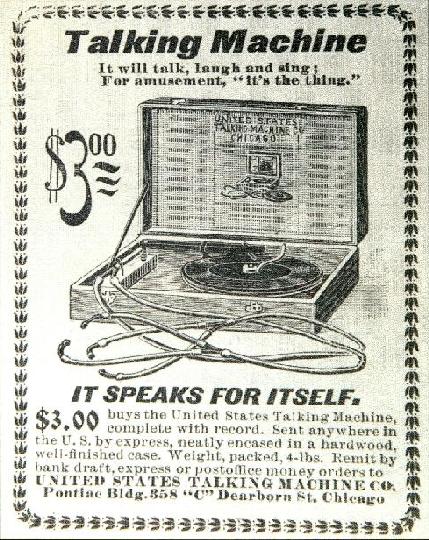



This very unusual disk gramophone was marketed in late 1897 by the United States
Talking Machine Co. of Chicago, priced at a mere $3.00. It is housed in a small oak
case, reminiscent of a cigar box, measuring only about 12 by 8 inches and only 3-1/2"
tall. The mechanism consists of a 7" turntable which is hand-driven, with no
motor. The tonearm is a simple piece of wood with a long needle pressed through the
end, and a sliding weight to control the tracking pressure. The vibrations of the
needle are transmitted through the solid wood to the other end of the tonearm, while
a spring resonator connected to two sets of conventional listening tubes allows the
sound to be heard. (The solid tonearm is reminiscent of another peculiar inexpensive
phonograph of the same era -- the Amet Echophone.)
Inside the lid is a large paper label with the company name and address, instructions,
and a list of records for sale. Though the the record manufacturer was unnamed on
the label, the list was comprised of Berliner Gramophone disks, with Berliner's own
catalog numbers.
Apparently, soon after this little machine hit the market
it caught the attention of Frank Seaman, soles sales agent for Berliner Gramophones
through his National Gramophone Company. Rather than fight the U.S. Talking Machine,
Seaman apparently opted to market them. Some United States Talking Machines are marked
with Seaman's National Gramophone name and address on the instruction sheet, and
carry a higher $3.50 price on the label.
Whenever or however Seaman first
became involved with the company, it ultimately failed -- most likely because of
the poor quality of the sound. It is a challenge to turn the vertical crank at a
steady speed for musical records, and the strange reproducer is not very effective.
By early 1898 the market had largely dried up, and in March the machines were offered
as subscription premiums in magazines such as "Youth's Companion," "Munsey's"
and "Ladies' World." It was a singularly unsuccessful Gramophone, and is
extremely rare today with only six known to exist. This example is in pristine original
condition, including the turntable felt and original ribbed rubber tubing.

Curiously, the label inside the lid shows a picture of the machine, with a picture within the picture within the picture!